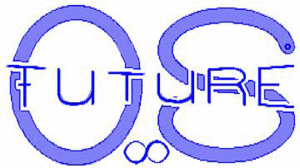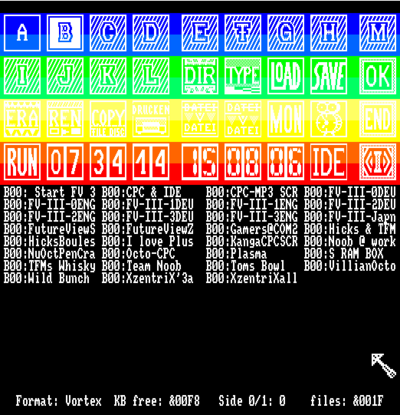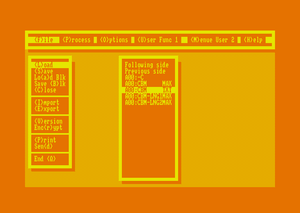Difference between revisions of "FutureOS"
(→OS supported Hardware) |
m (→Web links: - futureos.de works again) |
||
| Line 151: | Line 151: | ||
== Web links == | == Web links == | ||
| − | *[http://www.FutureOS.de FutureOS.de] | + | *[http://www.FutureOS.de FutureOS.de] |
| − | + | ||
*[http://groups.yahoo.com/group/FutureOS/ FutureOS Downloads & Mailing list] - Join Yahoo Groups! (why?) | *[http://groups.yahoo.com/group/FutureOS/ FutureOS Downloads & Mailing list] - Join Yahoo Groups! (why?) | ||
*[http://cpc-live.com/javacpc.php?system=FutureOS&title=FutureOS&full=true&boot=|os&disc=FutureOS_Darth.dsk&discb=FutureOS_Fraktal.dsk&discc=FutureOS_FV-I.dsk&discd=FutureOS_FV-II.dsk&disce=FutureOS_FV-III.dsk&discf=FutureOS_FV-IVeng.dsk&discg=FutureOS_NGC4650A.dsk Try and use FutureOS online at JavaCPC] | *[http://cpc-live.com/javacpc.php?system=FutureOS&title=FutureOS&full=true&boot=|os&disc=FutureOS_Darth.dsk&discb=FutureOS_Fraktal.dsk&discc=FutureOS_FV-I.dsk&discd=FutureOS_FV-II.dsk&disce=FutureOS_FV-III.dsk&discf=FutureOS_FV-IVeng.dsk&discg=FutureOS_NGC4650A.dsk Try and use FutureOS online at JavaCPC] | ||
Revision as of 06:13, 18 February 2010
Contents
Introduction
FutureOS is an operating system for the Amstrad CPC6128, 6128Plus, C-One and CPC TREX. The version for the CPCPlus supports some of its special features. FutureOS is developed by TFM of FutureSoft in Z80 assembler. The development of FutureOS and its applications continues from 1989 up to now (2009). FutureOS allows the user to control the computer with HIDs. The surface provides an icon section and a file section; it can deal with files up to 4 MB in one piece. It has a dynamic memory management system, which divides RAM usually into 16 KB blocks - or in smaller pieces. Further it supports a variety of hardware expansions. FutureOS is delivered together with a variety of utilities in the same four ROMs. Additional expansion ROMs can be added.
Requirements
The core of the OS needs 64 KB ROM. Compatible products are EPROM-cards, the ROM-RAM-BOX, SYMBiFACE II, RAMcard, Jareks Flash-ROM or similar products. If you don't own such a card, you can take a look at FutureOS by using a compatible CPC Emulator (WinCPC, Caprice, WinApe, CPCEmu).
The core of the OS itself is executed directly in (Pseudo-)ROM or EPROM (in four 16 KB blocks). It jumps between the ROMs with the help of a little common area. Therefore the numbers of the four 16 KB ROMs are hardcoded.
FutureOS uses 2 KB (&B800...&BFFF) of the first 64 KB; the remaining RAM is available to applications. Additional RAM can be reserved for DIRectory buffering. Furthermore the OS uses memory management (up to 4 MB), file-handling and specialized Low/Mid/High-level routines to access the hardware.
FutureOS can be launched from AmsDOS with the RSX commands |OS or |FDESK. If you use |FDESK you can leave FutureOS and get back to BASIC where you have stopped before - the first 48 KB (not the screen) have been preserved.
FutureOS only runs well on a CPC6128 or 6128plus (not CPC464 or 664), because of their support for RAM configuration C3 (essential for the mouse pointer). FutureOS is not compatible with native AMSDOS or CP/M programs.
User Interface
The User Interface (UI) of FutureOS presents the user with three sections: the icon section (upper half of screen), the file window (lower half of screen) and the message line (bottom of screen). It appears directly after starting FutureOS, but can also be used by applications. The user can browse through directories of discs and hard-disc partitions. The size of the text window is fixed, due to this 64 different file names can be displayed at once (this equals one complete directory of a data of system formatted disc f.e.). Instead of scrolling, you browse page by page through the used directories. A mouse pointer is used to select devices, functions or files; this pointer can be controlled with nearly all of the pointer based HID devices (joystick, mouse, trackball, light-pen, grafpad etc.) available for the CPC.
Applications can call the UI and the user returns to the application using the OK icon. The icons are fixed, therefore the layout remains stable throughout its use and on every CPC using FutureOS.
Files can be viewed on-screen (scroll up and down) or printed. When typing a text file it is possible to set the number of columns and lines of the window the text is displayed in.
File headers can also be viewed. FutureOS uses expanded but compatible file-headers, that allow a file to be up to 16 MB in length. The file-header can additionally specify the target RAM of a file. Further it can contain a file icon or a short file description.
CBM
The "command bar menu" (CBM) is an non resident part of FutureOS, which can be easily linked into applications. It's user interface consists of several flexible pull down menus and file selectors. Using CBM as the standard UI for FutureOS programs helps making them looking similar and useable in an intuitive way. A part of the CBM is located in the FutureOS ROMs, another part can be individually adapted to its target applications and will be integrated in the application itself.
File system
The file system of FutureOS can handle multiple simultaneous floppy disc drives and hard disc partitions. After the selection of the devices FutureOS reads and buffers the directory entries of the devices. Integrated utilities like the multi file copy can copy files from physical sources to different physical destinations in one run.
The file system is compatible with the CPCs native data-, file- and format structures (f. e. File header, Disc formats). FutureOS supports the Data, IBM, System, Vendor and Vortex (704 KB) disc formats.
Filenames can use all 256 different characters and user areas from 0 to 254 (except for &E5, which is reserved for deleted files). Unlike Amsdos, a file that is erased under FutureOS is not shifted to user &E5, but is physically removed from the directory. File headers are displayed as AmsDOS files or the icon-like file-header of a FutureOS program. An AmsDOS file header has 128 bytes of which are unused. FutureOS makes use of those unused bytes so that files have a length definition of 24 bit (16 MB file length) and can have a physical RAM select. Therefore a file can be defined to be loaded everywhere in the external RAM. Also a FutureOS file-header can contain a graphical icon, a textual icon or a short description of the file.
FutureOS includes the fastest FDC-based disc- and file-reading and writing routines for the CPC. This is possible by ignoring the interleave factor, reading one physical sector directly after each other to the correct position in memory but also by just starting with the first appearing sector of every new track. In addition the DIRectory is buffered in RAM, the head of the floppy must not step back to look for the next block. The track step rate is increased and can be adjusted for every drive. It's even faster than optimized copy programs like Crowns' Crime.
Implementation of Hardware
The OS supports many of the hardware available for the CPC. One of the ambitions of FutureOS is to support all hardware available. Hardware expansions usually need drivers that can be flexibly added to an OS. Contrary to this approach, a goal of FutureOS is to provide a monolithic architecture where all drivers are implemented in a hardcoded way.
- Disc drives and hard discs: FutureOS supports up to eight floppy disc drives and up to four hard disc partitions (Dobbertin HD20 hard disc). It buffers the directories read from any mass storage device in the expansion RAM to speed up drive access.
- Plug and Play: If a hardware expansion is connected to the CPC FutureOS will automatically detect that expansion, initialise it and make it available to user and applications. The architecture of the OS allows you to add and remove hardware on purpose (hot plug and play). You can switch external hardware on or off in the configuration bytes (use ConfigOS utility).
OS supported Hardware
printer ports
- 7 bit printer port (native)
- 8 bit printer port 6128 Plus (unclear it does not work on 464+ ???)
- 8 bit printer port patch (PIO) (unclear is that the "Happy Computer Mod" using CAS_WRITE as Bit7 ???) (might also refer to an older/bugged description of the PIO, see History of the PIO page, versions before 2010 listed /EXP as printer bit, which was nonsense)
Drives
- 3" A, B, C and D drives (C, D need hardware patch)
- 3.5" and 5.25" drive
- Atari ST 80 Track DS B-drive
- Dobbertin D-DOS Double drive. Up to four drives 80 track, doublesided.
- Dobbertin X-drive 80 tracks, DS (unclear what is that? maybe it means a Vortex X-Drive, like those listed below ???)
- Vortex disc drives FI-D, F1-S, F1-X, M1-D, M1-S, M1-X. Up to four drives 80 track, doublesided.
Expansion cards
Hard-disc
- CPC-IDE and SYMBiFACE II IDE support, but only low-level, FutureOS IDE-ROM needed
- Dobbertin HD20 (72 KB/s data transfer rate)
- IDE8255 IDE support, but only low-level, FutureOS IDE-ROM needed
Joysticks
- Analog Joystick (6128 Plus)
- Digital Joysticks 1 and 2
Memory expansions
- Dk'tronics 64-512 KB and compatibles (Dobbertin, Inicron, SYMBiFACE II)
- RAM7's RAM expansion (up to 2 MB)
- Jareks 4 MB RAM expansion up to 4 MB
Real-Time-Clocks
- Dk'tronics Real Time Clock (unclear is that true? the source files refer to "Happy Computer RTclock", not to "Dk'tronocs RTC")
- Dobbertin Smart Watch (at ROM select 15)
- SYMBiFACE II
Additional HIDs
The following pointer-based input devices are supported by the file management module. Applications can use them by calling the appropriate function in OS-ROMs A, C or D.
- Atari ST mouse and trackball adapter (Schneider Magazin)
- AMX_Mouse
- CPC-Mousepack (Reisware)
- Dk'tronics lightpen
- GEOS mouse (C64)
- Happy-Computer light pen (unclear what is that? DIY from german magazine?)
- Hegetron Grafpad II
- Lindy light pen (unclear what is that? who or what is Lindy? Seems to be an EPROM expansion for the C64?)
- Marconi trackball
- PS/2 mouse of SYMBiFACE II
ROM-included Utilities
The FutureOS roms already include several utilities as an addition to the operating system. Tools like copy (files or discs), format discs (data-, system-, ibm- and Vortex-format), erase files, rename files, type and print files, set alarm time, set time of RTC, verify discs or directory refreshing are available without the need to load them from an external medium. Multiple files can be copied between different physical media in one go.
A small machine monitor is also provided. This monitor provides features like CPU register editing, I/O ports, memory editing and display and manipulation of the ASIC contents (6128 Plus). Memory blocks can be copied or initialised. It is possible to call a routine with defined CPU registers (complete register set) and memory.
Developing for FutureOS
You can developp very freely, even the RST vectors are free usable. Also the second register set of the Z80 is freely usable.
- Z80 Assembler: You can use an assembler for AmsDOS or for CP/M. Switching between AmsDOS and FutureOS is fast and using |FDESK allows to come back to AmsDOS with the first 48 KB or RAM remaining untouched.
- Programming in C for FutureOS: With FIOLIB it also possible to use C as a programming language.
Applications / Demos / Games
The following programs can be downloaded at the FutureOS homepage, see Weblinks below.
- Captain Future (4 MB movie that uses Jareks 4 MB expansion)
- CBM (non resident OS expansion)
- Darth Vader (stand alone demo)
- FilmeMacher (movie player)
- FIOLIB (C library)
- Flash ROManager (management of Jareks Flash ROM expansion)
- FuturePlayer (MP3 and WAV player) - Ask TFM for MP3 files on discs
- FutureView (disc mag)
- Gerelakos (RPG under construction)
- GSED (Graphic Playground Editor for 2D / 3D games)
- GMSK (sprite converter)
- Gravitation Zero
- Kane (sprite grabber)
- Meg Ryan sample demo
- Return of the Sisters (a Giana Sisters Clone) WIP name "A tribute to the Sisters..."
- ROManager (management of the SYMBiFACE II Pseudo-ROMs)
- Rotating Fractal (stand alone demo)
- Star Trek sample demo
Conclusion
FutureOS is designed as an OS with fast system calls and support for nearly all CPC expansions. It has specialised file handling and memory management capabilities that support programs up to 4 MB und files up to 16 MB. The idea is that development of games, graphic tools, word processors, sound, management of big amounts of data, and programming languages are possible in this environment. At this point, the user can do all this, like listen to MP3 files, work with graphic, use and create C programs, watch movies, demos and play games.


